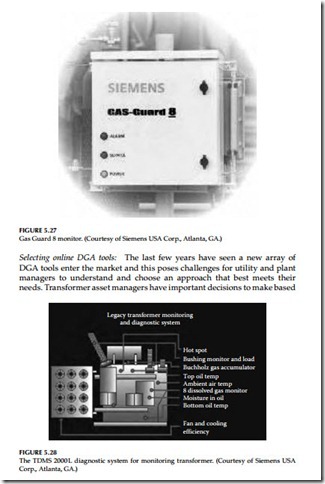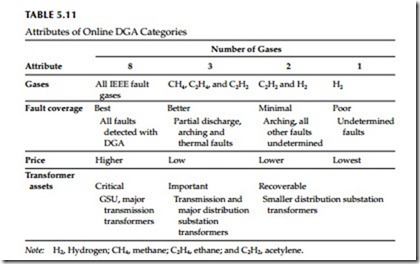Online Condition Monitoring of Transformers
Power transformers are critical and costly assets in the electric power system beginning with the grid, transmission, and down to the plant. They are one of the most important electric apparatus for providing reliable energy flow. As an asset class, transformers constitute one of the largest investments in a util- ity’s system or in an industrial complex. For this reason transformer condition assessment and management is a high priority. Each entity is unique and investment levels in asset condition and assessment management varies according to risk level and investment return models. While the models are different for each entity, the common element in them is that transformers are stratified according to the criticality of individual transformers. The variability and uniqueness lies in where the prioritization lines are drawn and the invest- ment amounts allocated for condition monitoring for each level. Typically this approach has the most critical transformers receiving the highest investment of condition assessment and management tools and less-critical or noncritical transformers receiving decreasing level of asset allocations.
A simplified model below shows one approach to transformer condition management:
Critical: Those transformers that, if failed, would have a large negative impact on grid stability, utility revenue, and service reliability of the critical facility. For example, generator step-up transformers (GSU) and transmission transformers that are part of critical power flows fall in this level, or the main transformers in a critical facility.
Important: Those transformers that, if failed, would have a significant negative impact on revenue and service reliability of a utility system, or the production of the plant. Transmission substation transformers and major dis- tribution substation transformers are generally in this level.
Recoverable: Those transformers that, if failed, would have low impact on revenue and reliability or the production of the plant. These are mainly smaller distribution substation transformers.
Transformer reliability is more important today than was in the past. Transformers do not last as long they used to in the past. In the United States, the average life of a transformer is 40 years, and many transformers installed in the 1960s and 1970s are now approaching the end of their design life. Higher loads placed on transformers, in a market that demands more electricity, have also taken their toll on transformer longevity. Because of consolidation and deregulation of the electric industry, the budgets for maintenance and condition monitoring have been reduced. Therefore, the need to more closely manage transformer assets becomes even more important these days. Utility and plant managers by choosing the appropriate transformer condition moni- toring tools can avoid unplanned failures, lower maintenance costs, and defer capital expenditures in replacement cost. Condition management is all about choosing the right monitoring tools for transformers.
5.9.1 Online Monitoring of Transformers
There are several online monitoring systems that can be used for continuously assessing the condition of large important and critical power transformers. The online monitoring systems that are available on the market are DGA, PF monitoring of bushing, leakage current monitoring of lightening arrestors, and FRA of transformer windings. The bushing and lightening arrestors are externally mounted auxiliaries on a transformer therefore they are more sus- ceptible to varying environmental conditions. A failure in the bushing or lightening arrestor of a transformer is a failure of the transformer. As discussed earlier, the online testing offers yet another management tool for condition monitoring and assessment of the most critical and important transformers.
DGA: The DGA is one of the many tests that are used in monitoring the health of oil-filled power transformers. The off-line DGA tests are discussed in Chapter 4. The off-line DGA tests have been traditionally carried out using labo- ratory DGA analysis performed at periodic intervals, such as on quarterly, semi- annually, or yearly basis. DGA of transformer oil is the single best indicator of overall condition of the transformer and is carried out without taking it out of service. This is a universal practice today that got started in earnest in the 1960s. The following is a brief summary of the evolution of the practice of DGA.
While laboratory or portable DGA is the traditional practice, the use of online DGA tools has gained in popularity. The reason for this is the need for utilities to maintain or improve their reliability in the presence of decreased capital expenditures and an aging infrastructure. Something more than periodic laboratory or portable DGA is needed to be successful in the current environment and the two approaches (online DGA and laboratory DGA) now coexist at many utilities. Online DGA helps utilities avoid unplanned failures, adopt lower cost condition-based maintenance, and defer capital expenditures by extending the transformer’s useful life.
First generation products (1970s), as well as some current online DGA prod- ucts available today, provided total combustible gas (TCG) or single gas (hydro- gen) monitoring. These products provide indication of developing problems in the transformer but offer no legitimate diagnostic capability. Online DGA offer- ings in the market have evolved from this early approach to include multigas monitors that detect and analyze some or all of the eight fault gases identified in the IEEE standards as well as provide diagnostic capability.
Newer online DGA products have the unique ability to continuously trend multiple transformer gases and correlate them with other key parameters such as transformer load, oil, and ambient temperatures as well as customer-specified sensor inputs. This capability enables utilities to relate gassing to external events, a key to meeting utility reliability and financial goals in the current environment. In fact, some online DGA tools may offer better accuracy and repeatability than laboratory DGA. This can improve the transformer asset manager’s decision timeliness and confidence when incipient faults are detected.
With the advent of online DGA monitoring, there has also been new learning about the nature of developing faults in transformers. Online DGA monitoring has produced multiple case studies that document the development of critical faults, which could cause catastrophic transformer failure if left undetected, in timeframes from a few days to a few weeks. There is a low probability of capturing these rapidly developing fault conditions with a laboratory or portable-based transformer DGA testing program.
Recently, the ability to automatically supplement traditional DGA diagnostic tests with online DGA tests is available in the market. This new development offers users of online DGA monitors unprecedented insight into the nature and identification of developing faults. The tools are typically ratio-based and the online data set enables trending of fault gas ratios over time rather than the traditional static snapshots. Diagnostic outcomes can now be determined quickly and with more certainty than in the past. Neural network diagnostic approaches utilizing DGA data are also new to the market and promise more accurate diagnoses but have not yet been included in industry standards.
One of the online tools that have recently become available for condition monitoring of transformers is the online DGA, such as Siemens Gas Guard 8 and TMDS 2000 L shown in Figures 5.27 and 5.28, respectively. The Gas Guard 8 is a self-contained fully automated closed-loop gas chromatograph designed to be mounted on or near the subject transformer. Through chromatography the Gas Guard 8 generates individual measurements of each of the eight critical fault gases (hydrogen, nitrogen, carbon monoxide, carbon dioxide, methane, ethane, ethylene, and acetylene) found in transformer oil. The accuracy of the measurements are commensurate with what one would expect to receive from a traditional laboratory.
The TDMS 2000 L DGA monitoring system allows condition assessment data to be incorporated into the configuration of alarms and recommended loading to mitigate the risk of failure while preserving operation. Although no system, including the TMDS 2000 L, can guarantee avoidance of failure, the TMDS 2000 L can utilize the results of field-based condition assessments and advanced monitoring and diagnostic technology to provide a comprehensive tool to support any asset management strategy. The TMDS 2000 system provides contextual information on maintenance activity to address abnormal operation, on potentially related or causal relationships between transformer components and the alarmed condition, reduces time consum- ing data analysis and delivers statistically relevant abnormal operating data and alarm conditions.
The following discussion provides some of the decision criteria for employing online DGA monitors.
on DGA information, including whether or not to take a transformer off- line in order to avoid a catastrophic failure. These decisions can significantly affect service reliability, revenue, and production. The aging infrastructure and increasing electricity demand placed on existing transformer assets is exacerbating the problem. Higher loading on older transformers is causing faults that can lead to catastrophic failure to develop faster and more often. The transformer reliability bathtub curve shows that new transformers are not immune to failure either. This puts pressure on transformer asset managers to make critical reliability and revenue decisions more quickly and more often than in the past. Each transformer asset manager must choose the amount and type of transformer condition data they require for each level in their condition management model to make these big decisions. In response to this need the vendor community has developed products that better support the asset manager’s decision integrity by supplying timely, accurate and certain transformer DGA data and diagnostic tools.
The increasing variety of online DGA tools, while helpful to the industry over- all, presents transformer asset managers with the problem of matching the right product to their needs. A framework for decision making is required. The first step is to determine a transformer condition management model. For purposes of this discussion, the model discussed above will serve the purpose. The model discussed above has three levels of transformer assets identified; critical, impor- tant, and recoverable. Table 5.11 contains a list of attributes for various online DGA product categories relevant to online DGA tool selection and how it could be applied to the three levels of transformer assets. This list of attributes should be considered when applying online DGA to the various condition management model levels. Online DGA tools can be categorized by attributes directly
resulting from the number of gases measured. Most modern online DGA tools offer the ability to measure other parameters such as moisture-in-oil. These other parameters are not included in the table as they are common for most.
Diagnostics: Fault coverage and diagnostics capabilities are the critical attributes that transformer asset managers should consider when choosing online DGA tools for the various levels in their stratification models. Price is also a consideration, but the relative value of the solution, as defined by the fault coverage and diagnostic capabilities, is the more important measure. In other words, some solutions may have a higher price, but the value provided (through superior transformer condition knowledge) in terms of improved utility service reliability and revenue far outweighs the higher price.
The selection of online DGA tools for each level of transformer assets identified reflects the approach of making the highest investment in online DGA tools for the most critical transformers and less investment in tools for lower levels in the stratification model. Notice that this approach utilizes the online DGA tools with the most fault coverage and diagnostics for the critical and important transformers in the fleet. Utilities will find more appropriate returns on investment for their critical and important transformers with online DGA tools that offer good fault coverage and diagnostics capability rather than with the lowest cost, poor fault coverage tools that lack diagnostic support.
The current environment of higher loading on aging transformers, deferred capital expenditures as well as increased service reliability requirements sug- gests that transformer asset managers should take advantage of the improved online DGA offerings (i.e., better fault coverage and diagnostics) in the market to get the best protection for its biggest asset class—at all levels. Appropriate online DGAmonitoring and diagnostic tools will help utilities avoid unplanned failures, lower maintenance costs, and extend transformer useful life.

